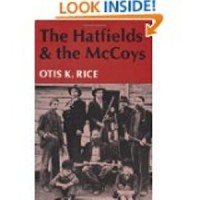Otis Rice told us on the first page of his Preface that newspapers “were so biased or so grossly inaccurate that they must be used with considerable discrimination.” Then he proceeded to cite newspaper reporters over one hundred fifty times in one hundred twenty-six pages of text in “The Hatfields & The McCoys.” The book is now considered one of the “standard and most reputable” sources on the history of the feud.
The majority of the citations in the footnotes to every one of Rice’s fourteen chapters are to newspaper writers. In three of his chapters, 6, 10 and 11, every one of the notes refers to a newspaper man.
In his coverage of the “quiet years,” 1883-86, in Chapter 4, Rice gives detailed accounts of both the “ambush of the innocents,” and the “tale of the cow’s tail.” In each case Rice’s book reads like either the testimony of an eyewitness, or a novel.
Rice writes: “Through mountain gossip and their own intelligence, the Hatfields learned that Randolph McCoy was planning a trip to Pikeville, evidently to consult with Cline.” Of course this presumes that Devil Anse was so concerned with Ran’l’s activities in 1884, when absolutely nothing had happened between the pair during the two years since Anse balanced the scales by executing his brother’s killers, that he was conducting some kind of elaborate intelligence operation to learn about Ran’l’s comings and goings.
It also presumes that Anse was too obtuse to know that the woods came down so close to Ran’l’s homestead that any Hatfield over the age of ten could have assumed a position in the edge of the woods and dispatched the old man at his leisure. The feud story demands an elaborate ambush.
Since we know that Rice looked at the Pike Circuit Court records—he mentions them several times—we know that Rice knew that Devil Anse didn’t have to exert any special effort to know when Ran’l would be going to Pikeville. The records show that when the Circuit Court was in session Ran’l McCoy was usually on the docket in either a civil or criminal matter, so, all Anse had to do was find out when the next session of Circuit began, and he would almost surely be able to ambush Ran’l on his way to Pikeville.
Rice’s description of the beating of the Daniels women with the cow’s tail is equally detailed. It reads exactly like it would if Rice had been physically present when the event occurred. Of course he adds a few details to tie it more directly to the feud, such as saying that when Cap beat the two women, he was “acting for the family.”
For both of these detailed accounts of events which are integral parts of his supersized “Hatfield and McCoy feud,” Rice gives ONLY newspapers as sources. For the ambush of the innocents, he cites an article from the Louisville Courier Journal, which appeared six years after the purported event, and one from the Pittsburgh Times, which appeared four years afterwards.
In support of his yarn about Cap Hatfield and Tom Wallace spraying the surface of Tug River in a vain attempt to hit Jeff McCoy from a distance of a few yards with Winchester rifles, he cites articles from the same two papers, written two years after the supposed event.
His primary source for the tale of the cow’s tail is the newspaper reporter, Virgil Jones.
Whether academia will admit it or not—and they haven’t yet admitted it—Otis Rice did not write a history of the Hatfield and McCoy feud. He aggregated the writings of newspaper reporters, which he said were “grossly inaccurate,” and seasoned them with a light dusting of actual historical records, and produced a book he hoped would sell to a gullible public. Of course he succeeded; not only do folks like the West Virginia Encyclopedia use Rice as a major source for “history,” but the book remains one of the best-selling books on the subject of the feud, more than thirty years after its appearance.
